Nissan Altima (L34) 2019-2024 Owners Manual: Forward-facing child restraint installation using LATCH
For additional information, see all Warnings and Cautions in "Child safety" and "Child restraints" before installing a child restraint.
Do not use the lower anchors if the combined weight of the child and the child restraint exceeds 65 lbs. (29.5 kg). If the combined weight of the child and the child restraint is greater than 65 lbs. (29.5 kg), use the vehicle's seat belt (not the lower anchors) to install the child restraint. Be sure to follow the child restraint manufacturer's instructions for installation.
Follow these steps to install a forward-facing child restraint using the LATCH system:
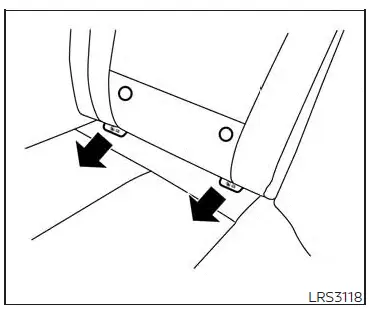
Type A (if so equipped) - step 1
1. Type A (if so equipped):
Remove the plastic covers from the LATCH anchors by pulling the covers straight back. Store the covers in a secure area.
Type B (if so equipped):
Lift the flap of the material to expose the LATCH anchors.
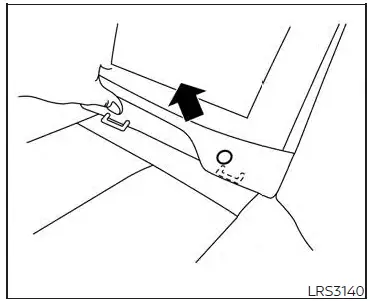
Type B (if so equipped) - step 1
2. Position the child restraint on the seat.
Always follow the child restraint manufacturer's instructions.
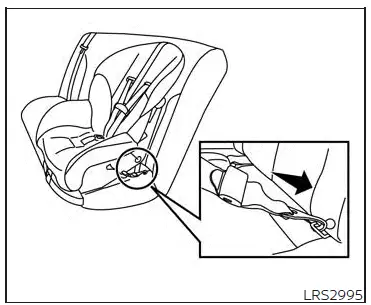
Forward-facing webbing-mounted -
step 3
3. Secure the child restraint anchor attachments to the LATCH lower anchors.
Check to make sure the LATCH attachment is properly attached to the lower anchors.
If the child restraint is equipped with a top tether strap, route the top tether strap and secure the tether strap to the tether anchor point. For additional information, see "Installing top tether strap".
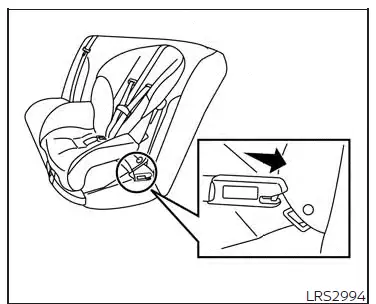
Forward-facing rigid-mounted - step 3
Do not install child restraints that require the use of a top tether strap in seating positions that do not have a top tether anchor.
4. The back of the child restraint should be secured against the vehicle seatback.
If necessary, adjust or remove the head restraint/headrest to obtain the correct child restraint fit. If the head restraint/ headrest is removed, store it in a secure place. Be sure to reinstall the head restraint/headrest when the child restraint is removed. For additional information about head restraint/headrest adjustment, see "Head restraints/ headrests".
If the seating position does not have an adjustable head restraint/headrest and it is interfering with the proper child restraint fit, try another seating position or a different child restraint.
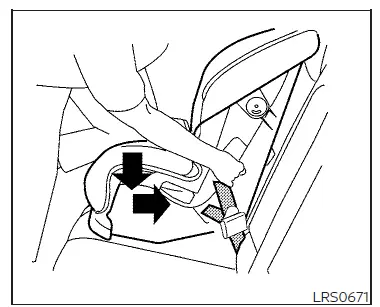
Forward-facing - step 5
5. For child restraints that are equipped with webbing-mounted attachments, remove any additional slack from the anchor attachments. Press downward and rearward firmly in the center of the child restraint with your knee to compress the vehicle seat cushion and seatback while tightening the webbing of the anchor attachments.
6. Tighten the tether strap according to the manufacturer's instructions to remove any slack.
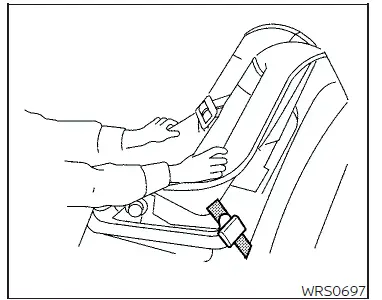
Forward-facing - step 7
7. After attaching the child restraint, test it before you place the child in it. Push it from side to side while holding the child restraint near the LATCH attachment path. The child restraint should not move more than 1 inch (25 mm), from side to side. Try to tug it forward and check to see if the LATCH attachment holds the restraint in place. If the restraint is not secure, tighten the LATCH attachment as necessary, or put the restraint in another seat and test it again. You may need to try a different child restraint or try installing by using the vehicle seat belt (if applicable). Not all child restraints fit in all types of vehicles.
8. Check to make sure the child restraint is properly secured prior to each use. If the child restraint is loose, repeat steps 2 through 7.
9. Type A (if so equipped):
If you remove the child restraint, reinstall the plastic LATCH anchor covers after use by pushing the covers straight onto the LATCH anchors.
Type B (if so equipped):
If you remove the child restraint, securely replace the flap by pressing the material firmly against the seat.
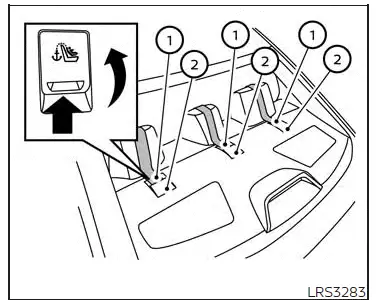
Rear seats
- Top tether strap
- Anchor point
Installing top tether strap
The child restraint top tether strap must be used when installing the child restraint with the LATCH lower anchor attachments.
First, secure the child restraint with the LATCH lower anchors.
Rear bench seat
OUTBOARD SEATING POSITIONS
1. Position the top tether strap 1 over the seatback.
2. Secure the tether strap to the tether anchor point 2 as shown.
3. Tighten the tether strap according to the manufacturer’s instructions to remove any slack.
CENTER SEATING POSITION
1. Position the top tether strap 1 over the seatback.
2. Secure the tether strap to the tether anchor point 2 as shown.
3. Tighten the tether strap according to the manufacturer’s instructions to remove any slack.
If you have any questions when installing a top tether strap, it is recommended that you visit a NISSAN dealer for this service.
WARNING
Child restraint anchorages are designed to withstand only those loads imposed by correctly fitted child restraints. Under no circumstances are they to be used to attach adult seat belts, or other items or equipment to the vehicle. Doing so could damage the child restraint anchorages.
The child restraint will not be properly installed using the damaged anchorage, and a child could be seriously injured or killed in a collision.

 Rear-facing child restraint installation
using the seat belts
Rear-facing child restraint installation
using the seat belts Forward-facing child restraint
installation using the seat belts
Forward-facing child restraint
installation using the seat belts